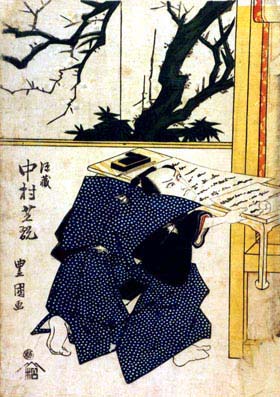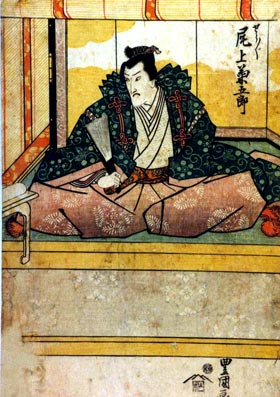| HIPPď DENJU |
| Play title | Sugawara Denju Tenarai Kagami |
| Authors | Takeda Izumo I Miyoshi Sh˘raku Namiki Senryű I Takeda Koizumo I (Takeda Izumo II) |
| History |
The play "Sugawara Denju Tenarai Kagami" was originally written for the puppet theater (Bunraku) and staged for the first time in the 8th lunar month of 1746 in ďsaka at the Takemotoza. It was adapted for Kabuki the following month and staged for the first time in Ky˘to at the Kitagawa no Shibai, produced by Nakamura Kiyosabur˘ I [casting]. It was also performed for the first time in Edo, at the Ichimuraza, in the 3rd lunar month of 1747 [casting]. This great play is based on the life of Sugawara no Michizane (845~903), a renowned scholar who was promoted up to the prestigious rank of udaijin ("Right Minister", one of the 2 close advisors of the Emperor). Falsely accused by Fujiwara no Shihei, the "Left Minister" (sadaijin), of trying to hatch a plot with Prince Tokiyo to seize the power, Sugawara no Michizane was exiled to Kyűshű. He dedicated his last years in writing poems, expressing both his homesickness and his innocence. After his death, the Emperor's residence was often struck by lightning and people thought it was done by the vengeful spirit of Sugawara no Michizane. A shrine was built in Ky˘to to appease the spirit, the Kitano Tenmangű, and Sugawara no Michizane was revered as a the God of calligraphy. In the play Sugawara no Michizane is called Kan Sh˘j˘. "At the time when the authors were working on the play, a great stir was caused in ďsaka by the birth of triplets. It was therefore decided to make use of triplets in the new production and thus it was that Matsu˘maru, Ume˘maru and Sakuramaru came into being. For the purpose of the story, the triplets are the sons of Sugawara's retainer, Shiratayű. When they were born, Sugawara stood sponsor to all three and named them after the trees he loved best, Matsu (Pine), Ume (Plum) and Sakura (Cherry). On their father's retirement, Ume˘maru took his place as Sugawara's personal retainer. At the same time his two others brothers were found equally worthy employment, one as the retainer of Prince Tokiyo and the other in the household of Sugawara's colleague, Fujiwara no Shihei. When Shihei's jealousy brought about Sugawara's downfall, the triplets became the victims of divided loyalties" (Aubrey and Giovanna Halford in "The Kabuki Handbook"). |
| Structure | The "Hipp˘ Denju" act is the third and final scene of the first act in the original structure of "Sugawara Denju Tenarai Kagami". It is usually staged as part of a t˘shi ky˘gen production. |
| Key words |
Daigo Tenn˘ Fujiwara Tokihira Gidayű Ky˘gen Giri/Ninj˘ Heian Jidai Jidaimono Kan Sh˘j˘ ďch˘mono ďdaimono Sugawara Michizane |
| Summary |
Kan Sh˘j˘'s Mansion Kan Sh˘j˘ was ordered by the emperor to chose his heir in the art of calligraphy. He couldn't think of anyone except his former student Takebe Genz˘, who was banished because of a love affair with Tonami, who had been an employee of Kan Sh˘j˘'s household. Kan Sh˘j˘ summoned Genz˘ and got the notice that he would arrive here today. Mareyo, who is a disciple of Kan Sh˘j˘, is fully confident that he will be the chosen heir. Genz˘ arrives at the palace with his wife Tonami. Poorly dressed, he is the shadow of his former self. They are kindly welcomed by Kan Sh˘j˘'s wife Sonoo-no-Mae and the lady-in-waiting Minase. Genz˘ feelings are mixed with joy and fear when he is told that Kan Sh˘j˘ is ready to meet him. He comes alone to the room of learning, without Mareyo. The Room of Learning Kan Sh˘j˘ asks Genz˘ how he has been after he had to leave the palace. Genz˘ answers that he has opened a village school to teach calligraphy to local children. Kan Sh˘j˘ is satisfied to hear that Genz˘ didn't forget the calligraphy that he had learned before. Then, he orders Genz˘ to write an example of his calligraphy. Although Mareyo comes on stage to interfere with Genz˘'s writing, Genz˘ manages to finish it. Kan Sh˘j˘ sees the sheet with pleasure and says that he will appoint him as his official successor and gives him his calligraphy book, a scroll full of secrets. Genz˘ is very glad, because he thinks to be allowed to join back Kan Sh˘j˘'s household. His former master says that of course Genz˘ has become the heir, but that it is a different problem to forgive his past love affair. Genz˘ cares more for Kan Sh˘j˘ than for the Imperial Court privileges. Yet, Kan Sh˘j˘ refuses Genz˘'s wish and asks him to leave the palace soon. Genz˘ is very disappointed because he is ordered not to appear in front of his former master anymore. A messenger comes to say that there is a summons from the emperor for Kan Sh˘j˘. The "Right Minister" doesn't know what it means. Kan Sh˘j˘ enters his private apartments. His wife Sonoo-no-Mae is back on stage, with Tonami hidden behind her outer coat as she would like to see her former master for the last time. Kan Sh˘j˘, dressed with the official Imperial Court dress, is back on stage. When Kan Sh˘j˘ leaves the mansion, his Court hat suddenly falls off. It seems to be an evil omen. Genz˘, his wife Tonami Sonoo-no-Mae are all worried for Kan Sh˘j˘ as the nobleman goes down the hanamichi. Mareyo is back and tries to steal the precious book from Genz˘'s hand. Genz˘ takes back the book and threatens Mareyo to kill him if he ever tries again. Genz˘ knows that the longer they stay the harder to leave the palace. They bow to Sonoo-no-Mae for the last time and humbly asked her to try to intercede one more time in their favor. Outside the Gate of Kan Sh˘j˘'s Mansion Ume˘maru comes rushing to the gate of Kan Sh˘j˘'s mansion. He shouts that his master Kan Sh˘j˘ has been apprehended and is being brought back to the mansion now. Kan Sh˘j˘ arrives on stage, guarded by armed men. The evil Fujiwara no Shihei used the secret love affair of prince Tokiyo and Princess Kariya (check the previous act for more details) as a tool to make the downfall of Kan Sh˘j˘. He ingeniously built the following fictitious incident: Kan Sh˘j˘ plotted to replace the present emperor with prince Tokiyo and intended to make Princess Kariya marry emperor Tokiyo in order to seize power. At a result, Kan Sh˘j˘ was accused of plotting the abdication of the present emperor. The emperor accepted the false accusation made by Shihei and decided to send exile Kan Sh˘j˘ into exite to Kyűshű. Mareyo, who has gone to the other side, tries to beat Kan Sh˘j˘ as a criminal. Ume˘maru is about to strike back in order to help his master, but Kan Sh˘j˘ stops him because he refuses to defy any of the emperor's orders. Ume˘maru keeps his patience unwillingly to prevent expanding Kan Sh˘j˘'s punishment. After Kan Sh˘j˘ goes through the gate of his mansion with Ume˘maru, the gate is completely closed. Then, Genz˘ and his wife Tonami appear on scene. They have hidden themselves because they worried about Kan Sh˘j˘. Genz˘ strikes the armed guards and knocks Mareyo down. Genz˘ was already banished and he has officially no more relationship with Kan Sh˘j˘, so he thinks that nobody can hold Kan Sh˘j˘ responsible for Genz˘'s fights. He manages to drive off the armed guards and knocks the barred gate. Ume˘maru suddenly appears on top of the wall. Genz˘ suggests to take Kan Shűsai, who is Kan Sh˘j˘'s little son, to a safe place. He is persuaded that Kan Shűsai might be killed and that the mansion is no more safe under these circumstances. Ume˘maru agrees with Genz˘ and passes Kan Shűsai over the wall to him. One of Shihei's spies is discovered and immediately. Genz˘ and Tonami walk down the hanamichi, secretly bringing Kan Shűsai back to their village. This summary was written by Sekidobashi Sakura (February 2002) and Sh˘riya Aragor˘ (Summer 2006) |
 |
 |
|
The actors Nakamura Shikan I and Onoe Kikugor˘ III playing the roles of Takebe Genz˘ and Kan Sh˘j˘ in the "Hipp˘ Denju" scene of the drama "Sugawara Denju Tenarai Kagami", which was staged in the 4th lunar month of 1819 at the Nakamuraza (print made by Utagawa Toyokuni I) |
|
|
|
| Contact | Main | Top | Updates | Actors | Plays | Playwrights | Programs | Links | FAQ | Glossary | Chronology | Illustrations | Prints | Characters | Derivatives | Theaters | Coming soon | News |